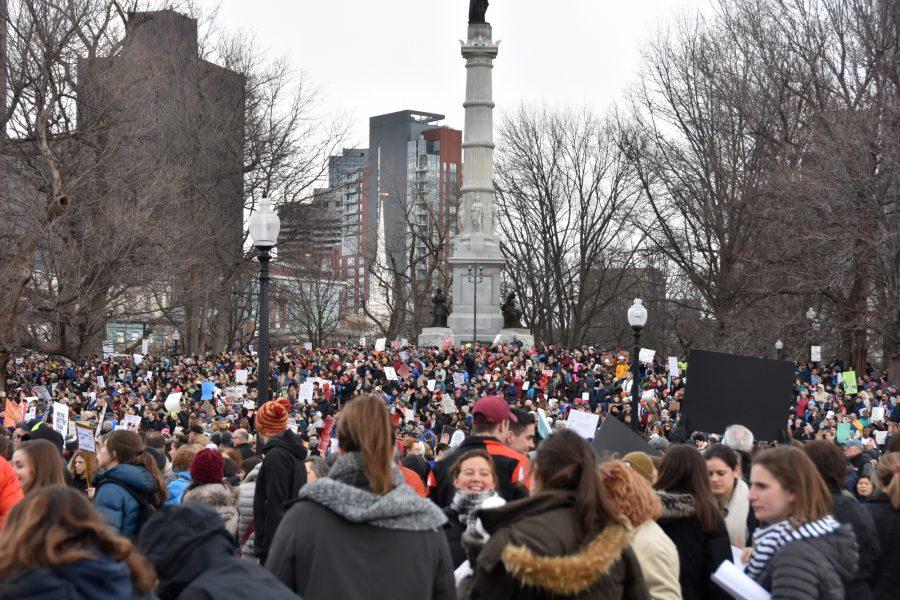I first started paying attention to the student activists from Marjory Stoneman High School when students across the US did a walk out on March 16.
The 2018 walk out was a long time coming. In my head, it started with Columbine. And in my head, it’s just one word, but what I’m referring to is the Columbine High School shooting in Colorado. I was in elementary school in New York when it happened. It’s strange, but the reason I remember my approximate age is because the doors between the two wings of my suburban elementary school building were locked all the time after the shooting happened. Before it was locked, it had been a nice shortcut through a flagstone courtyard with trees.
I vaguely remember images from the news of vigils in Columbine, candles alight, the same kind of thing we see today. Several years later when I was in high school, I vividly remember attending a schoolwide assembly called Rachel’s Challenge. Rachel Scott was the first student shot at Columbine. She was particularly well-known for her acts of kindness toward others. The program, created and led by Rachel’s father, challenged my fellow students and I to adhere to principles Rachel herself had penned a month before her death.
Although I think it was worthwhile, an implicit message of the program was: “If we’re all nicer to each other in high school, the shootings will stop.” Maybe that’s not exactly what the program meant to say, but to me it certainly seemed like the most important outcome in light of what happened at Columbine.
Looking back, I don’t remember a gun control conversation.
Which begs the question, how did I miss “Bowling for Columbine,” Michael Moore’s “incendiary,” “provocative” documentary that questioned Americans’ love of guns and violence, released in the wake of the Columbine shooting? I’m assuming it would have been hard to miss. It was a cultural phenomenon, scooping up lots of awards. I do remember seeing the posters and wondering about the name, which I knew had to do with the school shooting, but I didn’t get the bowling part. My white, suburban/rural, and generally gun-friendly cultural context at the time hardly encouraged me to go see it. (And I was in middle school in 2002 when it was released). In any case, the anti-gun wave that Moore provoked never reached me. Never even trickled down.
Nor did any other gun control message. While Moore was undoubtedly not a one-man advocate for gun-control in the early 2000s, it is evident that his cultural commentary, the increased security measures at schools, and programs like Rachel’s Challenge were insufficient to end mass shootings. Sadly, according to a CNN article titled “Mass shootings in America are a serious problem—and these 9 charts show just why,” the numbers articulate this point very well—of the 30 deadliest shootings in the United States dating back to 1949, 18 have occurred in the last 10 years, a statistic that includes not only shootings at high schools but at universities, in theaters, at concerts and clubs, and in churches as well. April of next year will mark the twentieth anniversary of the Columbine High School Shooting.
In more recent years, the problem of mass shootings has been increasingly connected to US gun control policy in no small part because of the surge of consciousness-raising led by the surviving Marjory Stoneman High School students. Suddenly a heady and ever increasing group of students and their supporters swelled the ranks of the pro-gun control camp. Anti-gun control advocates such as the NRA, bolstered in no small part by conservative gains in the 2016 elections, were suddenly being called out by visibly grief-stricken but incredibly articulate teenagers who by way of awful tragedy had the moral high ground. However, with the NRA’s cold, unfeeling responses, “polarization” took on a new shade of meaning.
Like so many issues, resolving the once-bizarre, still-horrific problem of mass shootings in America should *not* become polarized. We all have the same goal: to end mass shootings. Today I am encouraged by the widespread efforts of many Americans, particularly students and some policymakers, to contend with the issue directly and pragmatically. After the nationwide high school walk out on March 16, organizers came together again across the country for the March for Our Lives on March 24. Activists realized, however, that the action couldn’t stop there. Again occurring nationally, students and their allies on April 7 organized Town Hall for Our Lives, bringing their advocacy more directly to elected officials. Now I wait for their next step and consider the ways I can and should participate.
Maybe someday the doors of my elementary school will be unlocked and kids *will* walk through that flagstone courtyard again.
Gun Control: The Columbine to Parkland Conversation
April 11, 2018





















































